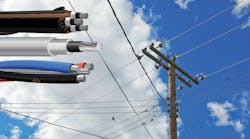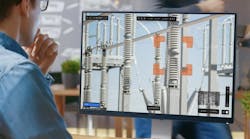With the increasing frequency of natural disasters including hurricanes, tornadoes, wildfires and winter storms, electric utilities have proactively transitioned overhead lines to underground circuits to minimize adverse weather impact and to enhance safety. However, many locations featuring congested utility pipelines, historical ruins underground, national reserved estuaries, waterways, and caverns might not allow for a complete and comprehensive underground conversion. Furthermore, tight project timelines to complete cable repairs or replacements and limited budgets might not permit a more costly and time-consuming underground design, installation, and maintenance program to be implemented. As a result, overhead projects are still being planned and built worldwide. This technical article discusses six categories of conductors, cable components, and performance characteristics to improve overhead resiliency with a focus on primary and secondary distribution systems.
1. Fully Compacted and Corrosion Inhibited Phase Conductors.
Service drop and secondary distribution cables are limited to circuits not exceeding 600 volts phase-to-phase or 480 volts phase-to-ground. All aluminum conductors (AAC) made with full hard-drawn 1350-H19 aluminum are common for low-voltage secondary lines, when maximum ampacity is desired using a light-weight conductor compared to ACSR with steel reinforcement, and when conductor strength is not a critical factor. For overhead sites located along coastal areas with extremely high saltwater contamination, the 1350 AAC phase conductors typically made with round strands can be fully compacted during the stranding process to narrow down the interstices within the conductor, which are prone to a longitudinal moisture penetration initiated from the conductor termination points. For example, a 4 AWG AAC full compact conductor is 8% smaller compared to the 4 AWG AAC with round strands. The reduction in overall diameter, not only minimizes the interstices for water-migration but also lowers the total cable weight due to the insulation coverage reduction. Furthermore, during the conductor manufacturing process, a corrosion-inhibiting compound can be injected into the stranded conductor before extrusion of the polyethylene insulation. This hydrophobic, thermally stable, electrically compatible, and corrosion-inhibiting material limits exposure to corrosive saltwater and in turn, preserves the service-life of the current-carrying phase conductors.
2. Corrosion-Resistant and Greased Aluminum Alloy Neutral Conductors.
For neutral-supported applications, one or more insulated phase conductors are plexed around a bare or covered neutral conductor. Therefore, the neutral conductor provides the ultimate mechanical, sag, and tension support for the entire assembly. ICEA S-76-474 standard lists all the conductor options including both copper and aluminum. For critical distribution circuits located in a wet climate, the bare stranded neutral conductor, typically made with a 1350-H19 hard-drawn aluminum (AAC) or aluminum conductor steel reinforced (ACSR), can be designed with either a 6101-T81 or 6201-T81 all-aluminum alloy conductor (AAAC). Although slightly lower in electrical conductivity than 1350 aluminum, neutral conductors made with 6101-T81 AAAC for Canada or 6201-T81 AAAC supplied in the US, offer an excellent corrosion resistance compared to 1350 AAC or ACSR (containing 1350 aluminum with a steel core). ACSR with a premium galvanized steel core (MA2) can also provide an excellent corrosion protection compared to standard ACSR. In addition to the alloy upgrades, a high-temperature grease can also be incorporated into the conductor interstices to further boost corrosion stability. The lithium-based complexed grease features an outstanding corrosion protection to acidic rain at elevated temperatures and an excellent resistance to water washout. Combining the premium conductor alloy with a high-performance grease, the neutral conductor can mechanically support the plexed cable assembly for overhead lines with a significantly reduced risk of long-term corrosion.
3. Flame-Retardant Insulation and Jacket Materials
For 600-volt service drop or neutral-supported cable constructions, an optional flame-retardant PVC jacket can be extruded over the flame-retardant crosslinked polyethylene insulation (FR-XLPE). One of the common cable flame tests, such as FT1, can be performed on the insulated conductor with an additional jacket. The flame-retardant additive incorporated into the insulation and the jacketing compounds retards flame propagation and shortens burn duration. Any low voltage cables including photovoltaic (PV) wires, covered lines, protected transformer risers, and covered jumper applications can be produced with flame-retardant materials to mitigate fire risks and improve overhead line safety.
4. Track-Resistant, Abuse-Tolerant, and Crosslinked, Covered Conductors.
For primary overhead distribution lines located in urban cities or dense growth tree areas, bare conductors such as ACSR, AAC (1350-H19), AAAC (6201-T81), or hard-drawn copper can all be converted to covered conductor designs. Covered conductors installed on insulators should continue to be treated like bare wires, due to the unshielded designs, but the covering allows for utility maintenance crews to reduce the tree trimming frequency and to minimize the power outages resulting from momentary contacts from objects. The covering helps to reduce faults due to high wind or other weather events when objects such as tree limbs or adjacent conductors might come in contact. The dielectric covering materials also serve to protect wildlife such as birds-of-prey. Because of the medium-voltage cable ratings (commonly rated 15-35 kV line-to-line), a 3-layer design, containing a semiconductive conductor shield, a linear-low-density polyethylene (LLDPE) inner, and a track-resistant high-density polyethylene (HDPE) outer layer, delivers the most reliable performance. The 3-layer cable construction manufactured using “true-triple extrusion” equipment, where all three materials are extruded simultaneously over the bare conductor, will create a strong and cohesive bond, eliminating potential delamination or voids that may be generated during a service life of thermal cycling. Dielectric covering materials can be produced with either thermoplastic or thermoset compounds. For a standard 3-layer design for 15, 25, or 35 kV rated voltages meeting ICEA S-121-733 industry standard, all three layers need to be crosslinked to sustain a 90 oC continuous conductor temperature during normal operation. The thermoplastic counterpart, made with non-crosslinked formulations, can only be exposed to a maximum conductor temperature of 75 oC during normal continuous operation. A thermoset construction presents several engineering advantages, including superior heat stability, chemical resistance, an enhanced moisture barrier, and better physical properties compared to a non-crosslinked polyethylene design. Spacer cable systems can also be deployed in metropolitan cities or heavily wooded areas where the ultimate compacted line design to maintain the highest clearance is the only solution. A high-performance non-conducting plastic spacer, which is attached to a messenger, will maintain the 3-phase covered conductors in fixed positions and in close proximity without initiating arcs or flashovers.
5. Weather Resistant Dielectric Materials for Aboveground Installs.
The weather-resistance of dielectric material is an equally- important characteristic to achieve the ultimate life expectancy of any cable installed above ground. Regardless of whether it is constructed as a single-layer insulation for 600 V service drops, multi-layer coverings for MV-rated tree wires, or an optional overall jacket, sunlight resistance for any dielectric material is accomplished by adding ultraviolet (UV) stabilizers and/or blockers within the compound blends. The proper selection of UV-inhibiting additives with sufficient concentrations will block harmful ultraviolet radiation from degrading the dielectric polymer. Leaving unprotected, the polyolefin family (LLDPE, HDPE, XLPE, LSZH, and etc.), polyvinyl chloride (PVC), and other common wire and cable compounds, will undergo chain scission reactions and physical breakdowns of the long-chain molecules that will eventually result in not just faded colors but also brittle fractures. Degraded polymers exhibit a much lower dielectric breakdown strength, physical, and thermal properties compared to new or protected material.
6. Fully Shielded Preassembled Aerial Medium Voltage Cables.
Preassembled self-supporting aerial MV cables are designed for overhead installation on poles, towers, or between buildings where the cost of underground ducts or direct burial methods cannot be justified or where aerial space and safety does not permit bare or uninsulated conductors. The fully shielded and self-supporting cable assemblies can also be adopted where both overhead and underground right-of-way issues prohibit conventional installation methods. For standard primary underground (UD) cables rated 5-35 kV that need to be brought above ground due to several reasons described above, preassembled aerial MV cables, also known as aerial bundled conductors (ABC), are the best design choice. For example: 15-kV MV cables preassembled with a moisture blocked 1350-H16/H26 aluminum stranded conductor with a Tree-Retardant Crosslinked Polyethylene (TR-XLPE) insulation system, fully shielded using concentric copper neutrals and finished with a Linear-Low-Density Polyethylene (LLDPE) jacket. The parallel conductors containing up to 3 phases are lashed onto a copper-clad messenger and are secured with a helically applied LLDPE covered copper binder. Due to a much greater cable assembly weight, the typical project has a span length less than 250 feet. The most common industry standard is ICEA P-79-561 entitled “Guide for Selecting Aerial Cable Messengers and Lashing Wires”, which provides the maximum recommended span lengths based on the total weight of the assembly and the type of messenger used. For areas where wildfire risk is high and where corrosive acid gas or smoke released from burning might be impossible to dissipate quickly, then a flame-retardant aerial bundled MV cable design, can be deployed. Non-lead EPR insulation system made with a helically-applied copper tape shield and finished with a Low Smoke Zero Halogen (LSZH) jacket are designed and manufactured to UL-1072 standard (medium voltage power cables) carrying an optional flame rating of FT-4/IEEE 1202. These flame-retardant MV cables are most popular for industrial or commercial applications, including petrochemical, oil & gas, automotive, datacenters, and other commercial projects.
The diverse range of overhead and underground wire and cable products along with a vast range of intelligent solutions offered in the current marketplace enable us to design, select, and synergistically achieve an optimum reliability and resiliency of the power system infrastructure. Southwire will continue to collaborate with electric utilities to upgrade cable systems according to geography, climate, and the operating conditions for each unique build. Cable system life can be extended beyond the 40-year design limit by applying one or more of the material recommendations and engineering principles showcased in this article.
Sponsored By:






